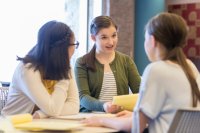Guiding Students to Apply What They Learn
A state Teacher of the Year used project-based learning to push her students to think critically and apply their learning in math.
Your content has been saved!
Go to My Saved Content.My school has been encouraging the use of project-based learning (PBL) for many years, but the math department—which I’m part of—was very slow to adopt it. I bought into myths about PBL—that it takes too long, that it’s hard to assess, etc.
I wasn’t opposed to all innovations: I flipped my classroom. I allowed my students to move at their own pace. I was the first in my school to adopt a competency-based approach in my class.
But while my students were mastering individual mathematical skills, they were missing the big picture. My assessments were well aligned to the practice work and the standards, but they rarely asked students to transfer and apply their knowledge. These assessments gave me clear information about a standard on its own but not about my students’ ability to problem-solve and think critically.
Why I Chose PBL
I needed an authentic assessment that would ask students to use their skills outside the context of my class, and it seemed that PBL would help my students transfer their knowledge. And I thought that PBL could challenge my students in a way that I had never challenged them before by requiring creativity, grit, and real problem-solving.
I knew that some of my students were also taking psychology and that statistics has countless applications in that field, so I approached the psychology teacher. We began by comparing our standards to see where we might collaborate. We found that one of the Common Core math standards, “Recognize the purposes of and differences among sample surveys, experiments, and observational studies; explain how randomization relates to each,” was similar to one of the psychology standards.
Next we broke down the standard to come up with a task. The students would need to design both a survey and an observational study that would answer research questions they would design themselves. They would need to explain how they used randomization to select samples.
We also needed to ensure that the task would be authentic. The psychology teacher had a connection at the local elementary school, so we decided that our students would design their research questions around things that could be observed there.
So we had our authentic task: “What would you like to learn about the state of elementary education today? What can you learn about the patterns and behaviors of elementary school students through observation and data analysis?”
Students spent two weeks planning for a day of observations at the elementary school, and they wrote survey questions. They had to gather analyzable data on variables of their own choosing, and then they had to report objective findings.
Scaffolding the Project
I needed to scaffold the work to make sure that my students felt supported throughout the process. Most of them had never done anything like this before, especially not in math.
I first decided how I was going to assess them. I wrote a rubric that broke down the standard into its parts, and separated the rubric requirements into stages in the project description, outlining what needed to be accomplished for each stage.
I scheduled frequent reflections on the process, and my students refined their research questions based on those reflections.
We had mini-lessons along the way. I planned some, like explaining the technology tools students would use to record and analyze the data; others were spur of the moment, based on needs that came up as the students worked.
What Authentic Learning Happened?
It was amazing to see real grappling with problem-solving. For example, students debated what the research questions should be, asking questions like, “I like that idea, but can we actually observe that?” and “How can we make that more specific and measurable?”
My students felt overwhelmed by the prospect of observing all the variables they had decided upon for all 22 students in the classroom they would visit. That led to a great conversation about sampling. Previously, I would have defined concepts like biased sample, stratified sample, and so on, but this time around the students came up with these concepts organically, and I was able to tell them that their ideas had names already.
They also had to grapple with how to record the data. Designing a spreadsheet was a huge challenge because they wanted to collect data that included timestamps. It took them a few class periods to decide how to handle this data collection, and then another few class periods to figure how to translate the timestamps into numbers they could actually look at on histograms.
The project helped students see the differences between surveys and observational studies. They noticed bias in their survey questions and potential bias in the survey responses. They noticed human error in their observations. They noticed the inadequate response rate to their survey from teachers. In other words, they were becoming real statisticians.
The Results
My students learned math by doing—they didn’t need to be spoon-fed definitions, formulas, and procedures. And this learning will stick: Later in the semester, students referred back to their experiences with this project to explain new concepts.
I had never been sold on the idea of an authentic audience—I thought the work during the project was the meaningful component. PBL taught me otherwise. Because my students knew they would be working with real subjects and they would present their findings to a group of adults, they worked really hard on their plans. They felt the pressure of a real deadline because we had a set observation day they needed to be prepared for.
My students were excited and proud of their efforts. They worked on this at several points without being prompted to, and even now they continue to talk about how they could make a project like this better in the future.
